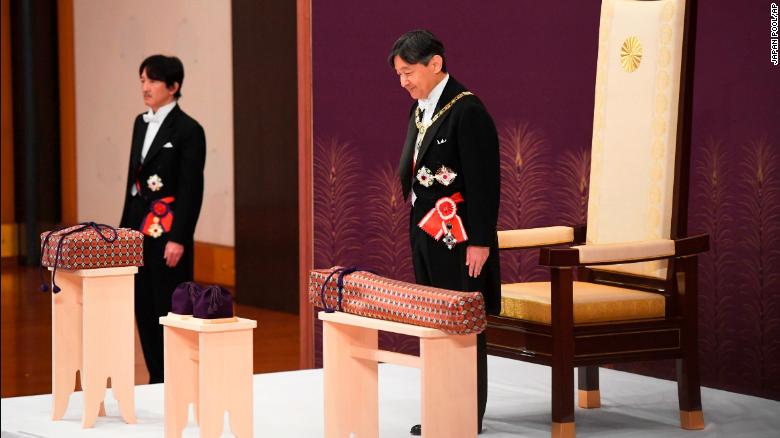Naruhito: Japan's emperor formally proclaims enthronement in centuries-old ceremony

(CNN)Japan's Emperor Naruhito has officially proclaimed his enthronement, in a ritual-bound, centuries-old ceremony attended by more than a hundred dignitaries from around the world.
The head of state began his reign in May, after his father, Akihito, became the first emperor to abdicate in 200 years. But on Tuesday, Naruhito, 59, announced his change in status to the world, in an elaborate series of rituals known as "Sokui no Rei" at the Imperial Palace in Tokyo.
As the ceremony began, purple curtains were pulled back to reveal Naruhito and his wife, Empress Masako, 55, sitting in two ornately decorated thrones.
Naruhito wore a rust-colored robe -- just as his father did during his own enthronement in 1990 -- while Masako wore a patterned, white robe and topped her traditional hairstyle with a gilded headpiece. The brother of Emperor Emeritus Akihito, 83-year-old Prince Hitachi, watched the proceedings from a wheelchair.
Reading from a large piece of paper, Naruhito then proclaimed his enthronement before an audience of the imperial family.

Emperor Naruhito during the enthronement on October 22, 2019.
"I pledge hereby that I shall act according to the Constitution and fulfill my responsibility as the symbol of the State and of the unity of the people of Japan, while always wishing for the happiness of the people and the peace of the world, turning my thoughts to the people and standing by them," Naruhito said.
"I sincerely hope that our country, through our people's wisdom and unceasing efforts, achieves further development and contributes to the friendship and peace of the international community and the welfare and prosperity of humankind."

Japan's Emperor Naruhito makes his appearance during a ceremony to proclaim his enthronement to the world at the Imperial Palace in Tokyo, Japan, on October 22, 2019.
Prime Minister Shinzo Abe stood before Naruhito's throne, and read a speech. He then bowed deeply and yelled: "Long live the emperor!"
As Naruhito ascended the throne, boxes were placed next to him that are believed to contain a sword and ancient jewel that, according to legend, date back to the mythical forefather of Japan's first emperor, Jimmu, who ruled almost 2,700 years ago. Along with a fabled octagonal mirror, they form Japan's royal regalia, or the Three Sacred Treasures. The sword and the jewel are so sacred that they've never been seen in public.
Naruhito will also receive felicitations from local -- and international -- representatives. Earlier in the day, Naruhito donned a white robe to pray at Shinto shrines in the Imperial palace.

Japan's Emperor Naruhito, in a white robe, leaves after praying at "Kashikodokoro", one of three shrines at the Imperial Palace, in Tokyo, on October 22, 2019.
A number of high-profile guests were in attendance, including Britain's Prince Charles and embattled Hong Kong leader Carrie Lam. South Korea's Prime Minister Lee Nak-yon was also on the guest list, despite an ongoing trade spat between South Korea and Japan.
The enthronement ceremony will be followed by an imperial banquet on Tuesday night.
Celebrations tempered
The high-profile occasion comes as Japan reels from Typhoon Hagibis -- one of the strongest storms to hit the country in years. The typhoon left dozens dead and caused extensive damage after it smashed into the country earlier this month.
The devastation prompted the palace to postpone a 4.6-kilometer (2.9-mile) public parade from the Imperial Palace to Akasaka Palace until November.
On Friday, the government announced that about 550,000 petty criminals will be pardoned to mark the emperor's enthronement.
Chrysanthemum traditions
Naruhito -- whose name means "a man who will acquire heavenly virtues" -- became the 126th Emperor of Japan in May, the latest in an unbroken line that stretches back 14 centuries.

In this handout image provided by Imperial Household Agency, New Japanese Emperor Naruhito delivers his first speech after ascending the throne during the enthronement ceremony at the Imperial Palace on May 1, 2019 in Tokyo, Japan.
Naruhito's ascension signaled the start of the "Reiwa" era. Each emperor's reign is marked by their era name, Naruhito's era name was adapted from an 8th century anthology of classic poetry and means "beautiful harmony."
The role of Japan's emperor has changed significantly since Naruhito's grandfather, Emperor Hirohito, sat on the throne. Once considered the living embodiment of gods, the emperor has become a largely symbolic figure.
Unlike other monarchs, Naruhito is a symbol of the state rather than the head of state, and the Japanese emperor wields no political power.
Naruhito took the throne after his father, Akihito, became the first emperor to abdicate the Chrysanthemum Throne in modern history. In addition to being the first in centuries to abdicate, Akihito was the first Japanese Emperor to marry a non-royal speak to his subjects live on television and to be hands-on in raising his children.
Naruhito, who became the first Japanese royal to study abroad, has pledged to continue his father's legacy and work to break down the barriers between the emperor and his subjects.
Correction: This story has been updated to correctly identify the brother of Emperor Emeritus Akihito.
CNN's Euan McKirdy contributed to this write.


Post a Comment